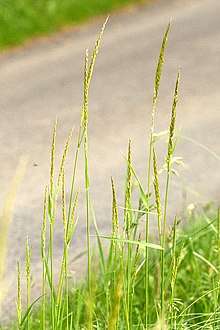Trisetum flavescens
Trisetum flavescens, the yellow oatgrass[1] or golden oat grass, is a species of grass in the family Poaceae. It is native to Europe, Asia, and North Africa.
| Trisetum flavescens | |
|---|---|
 | |
| Scientific classification | |
| Kingdom: | Plantae |
| Clade: | Tracheophytes |
| Clade: | Angiosperms |
| Clade: | Monocots |
| Clade: | Commelinids |
| Order: | Poales |
| Family: | Poaceae |
| Subfamily: | Pooideae |
| Genus: | Trisetum |
| Species: | T. flavescens |
| Binomial name | |
| Trisetum flavescens (L.) P.Beauv. | |
It can be found elsewhere, such as sections of North America, where it was introduced as a rangeland grass for grazing.[2] It now exists in the wild as a common weed.
Description
Trisetum flavescens is a perennial bunchgrass growing in clumps up to 60–80 centimetres (24–31 in) tall, and known to exceed 1 metre (3.3 ft) at times.
The inflorescence is a narrow panicle which is greenish yellow to purple when new and ages to bright golden yellow.[2][3]
The grass is susceptible to yellow oat grass mosaic virus (YOgMV), a virus of genus Tritimovirus.[4]
Toxicity
This grass is noted for being toxic to livestock, causing calcinosis, the deposition of calcium in soft tissues including muscle and tendons, the heart and large arteries including the aorta. Cattle suffer difficulty in moving and standing and reduced milk production.[5] Goats suffer heart murmurs and arrhythmias, weight loss, difficulty in walking, kneeling, and rising, and reduced milk production.[6] Horses suffer tenderness in tendons and ligaments, weight loss, and problems with movement.[7]
References
- "Trisetum flavescens". Natural Resources Conservation Service PLANTS Database. USDA. Retrieved 15 December 2015.
- Grass Manual Treatment Archived 2012-06-08 at the Wayback Machine
- Dixon, J. M. (1995). Trisetum flavescens (L.) Beauv. (T. pratense Pers., Avena flavescens L.) Journal of Ecology 83:5 895-909.
- Hassan, M., et al. (2009). Identification and characterization of a novel Tritimovirus species isolated from wild Trisetum flavescens L., family Poaceae. Virus Genes 39:1 146-52.
- Braun, U., et al. (2000). Enzootic calcinosis in 16 cows from 6 dairy farms in Unterengadin. Schweiz Arch Tierheilkd. 142:6 333-8.
- Braun, U., et al. (2000). Enzootic calcinosis in goats caused by golden oat grass (Trisetum flavescens). Veterinary Record 146 161-2.
- Grabner, A., et al. (1985). Enzootic calcinosis in the horse. Tierarztl Prax Suppl. 1 84-93.
- Ess. Agrostogr. 88, 153. 1812
External links
| Wikimedia Commons has media related to Trisetum flavescens. |
| Wikispecies has information related to Trisetum flavescens |
- GrassBase entry: Trisetum flavescens
- "Trisetum flavescens". Germplasm Resources Information Network (GRIN). Agricultural Research Service (ARS), United States Department of Agriculture (USDA).
- Jepson Manual Treatment: Trisetum flavescens